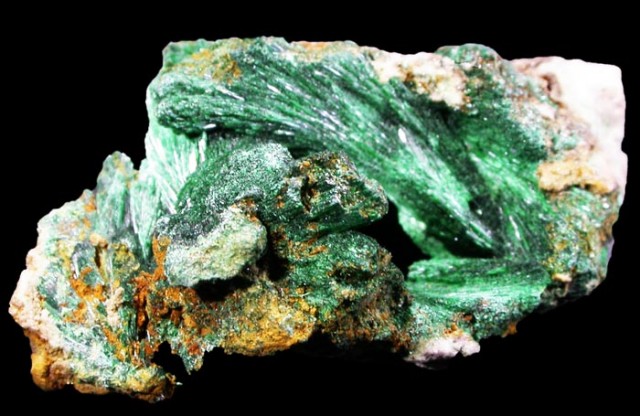
Malachite Stone: Meaning, Uses, and Properties
 If you’ve never heard of the alluring malachite stone, allow us to enlighten you! This tender stone is an opaque mineral variety composed mostly of copper. Malachite packs strong energy that’s great for protection and healing.
If you’ve never heard of the alluring malachite stone, allow us to enlighten you! This tender stone is an opaque mineral variety composed mostly of copper. Malachite packs strong energy that’s great for protection and healing.
So what’s behind the swirling mysteries within the malachite stone? Keep reading as we cover everything from its properties to its powers in our comprehensive malachite stone guide.
What is a Malachite Stone?
Malachite is a vivid copper carbonate mineral known for its many shades of green displayed in captivating color banding and spiraling patterns.
While it was first officially classified as a gem in 1747, malachite has been around for thousands of years. It was used as a source of copper for centuries, but not as much anymore. Since it isn’t found in as large amounts as it used to be, most malachite mined today goes to jewelry or cabochons.
In the celestial realm, malachite is associated with the planets Jupiter and Venus. In astrology, Jupiter represents broadening your mind and acquiring new knowledge. Venus is all about refinement and pleasure. Malachite’s spiritual traits of clarifying thoughts and feelings, as well as absorbing negative energies, connect to these planets’ sensibilities.
Are you an ambitious Capricorn or Scorpio? Well, we’ve got a zodiac stone for you. Malachite’s strong, consistent energy is the perfect companion for staying focused and determined to achieve your highest goals.
With a little malachite background under your belt, it’s time to dive into its scientific qualities.
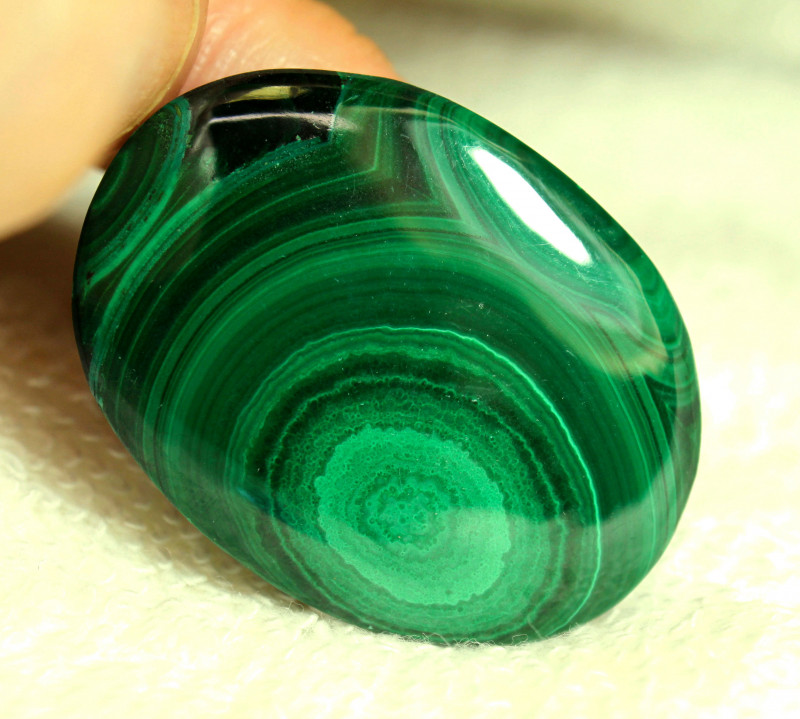
Malachite Specifications and Characteristics
Malachite is an opaque mineral made up of carbon, copper, and hydroxide. Copper makes up the majority of its chemical structure, about 58%.
Because it’s so prominent in copper deposits, it’s called the “prospecting guide” as miners often look for it to know where they should dig deeper for copper. Pretty neat, right?
On the Mohs hardness scale, malachite ranks at a lower mid-range of 3.5 to 4.5 and is about as hard as a copper penny.
Malachite Specifications
Chemical compound: Copper carbonate
Mohs scale: 3.5 to 4.5
Color: Pale green to dark green (various shades in between)
Streak: Light green
Crystal structure: Monoclinic
Luster: Usually silky; Sometimes adamantine in its rare crystal form; Some masses are dull or vitreous
Transparency: Opaque, sometimes translucent
Refractive index: 1.85
Density: 3.6 to 4.0
Cleavage: Perfect, 1 direction
Optical effects: Chatoyancy (sometimes)
Now that you’ve got a handle on malachite’s scientific traits, let’s take a look at what makes it special as a gemstone.
Malachite Colors and Varieties
Malachite lends itself to a myriad of cuts, thanks to its brilliant coloring and patterns. Because it’s almost always found as an opaque stone, the most common cuts are cabochons and beads.
Good lapidaries will sometimes let the stone’s patterns inform what cut they choose. Malachite stones with eye-like circles can be highlighted with rounded shapes, like beads or eggs. More intricate banding is great for carved figurines or other ornamental pieces.
Malachite’s color is its most popular quality. The green color is due to copper’s presence in the stone. All malachite stones are green, but their hues can range from the pale green of honeydew to the deep green of an evergreen tree.
Besides its green shade, malachite is also characterized by its color banding. Color banding, or color zoning, is when color is unequally distributed throughout a stone.
Malachite’s color banding usually displays mesmerizing concentric circles, similar to tree rings, that twist and spiral into each other.
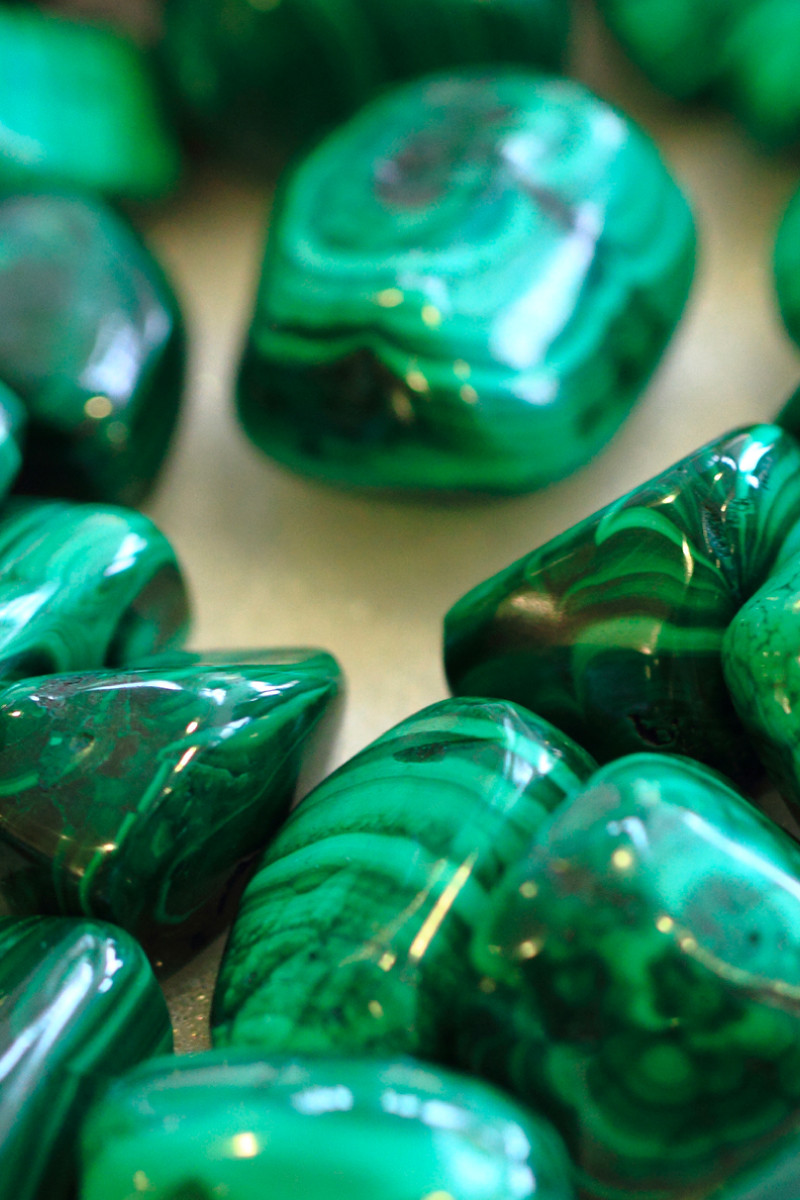
The different shades in these color bands are actually because the crystallite grains are different sizes. Under magnification, lighter shades show thin, fibrous crystals. Crystals in the darker shades are coarse, so it’s easy to see their mineral grains with the naked eye.
Sometimes these grains aren’t malachite but gemstone inclusions or other minerals.
Some of the stones found intertwined with malachite include turquoise or chrysocolla. Another notable combination is Azurite-Malachite, also called Azurmalachite.
Azurite is another copper carbonate stone that grows near malachite, sometimes banding together with it. Azurite’s blue shades mix with malachite’s green tones to create a stunning stone that looks like Earth viewed from space.
These pieces, along with typical malachite stones, can have varying values according to their carat weight.
Size and Shapes
With malachite, carat weight can factor into cost with polished pieces, but it’s not as straightforward. Since malachite is too opaque to be faceted, its carat weight doesn’t carry the same importance as it would for other stones.
With malachite stones, more can cost less, too. Bundles of multiple malachite pieces, also called parcels, will occasionally cost less than individual stones. This is similar to the idea of buying in bulk at grocery stores, just applied to gems.
Malachite History
For thousands of years, malachite has been used in a variety of ways. Since its prominence began in 4000 BC, people have used it to carve sculptures, adorn jewelry, and create green pigment, just to name a few ways.
In fact, an author from 2300 BC, Ptahhotep, referenced it while sharing advice in his Instruction in Wisdom:
“Knowledge has no limits, and none has yet achieved perfection in it. Good speech is more hidden than malachite.”
As a decorative element, malachite has often graced the halls of royalty. In Russia, the iconic St. Isaac’s Cathedral, ordered by Czar Alexander I, had 8 columns covered in malachite. The Winter Palace, home for many Russian emperors, even has an entire Malachite Room containing about 400,000 pounds of it!
Malachite’s use as a pigment goes all the way back to ancient Egypt. Apart from ancient Egyptians using it for jewelry and sculpting, it was a key pigment for creating green paint. Paintings inside Egyptian tombs often contain malachite for this reason.
However, this paint trend didn’t end with Egypt. As one of the only sources of green pigment for many centuries, malachite can also be found in European paintings from the 1600s and 1700s.
It didn’t just stay on walls, though. Ancient Egyptians, Greeks, and Romans used the stone to adorn themselves with green eye shadow, called kohl, and malachite amulets. While we’re sure their makeup was on point, malachite dust is toxic when inhaled. So if you want to emulate them, we suggest sticking with an amulet.
Native Americans are another group that utilized malachite’s powers, creating wonderful malachite jewelry to enhance their connection to the spiritual realm.
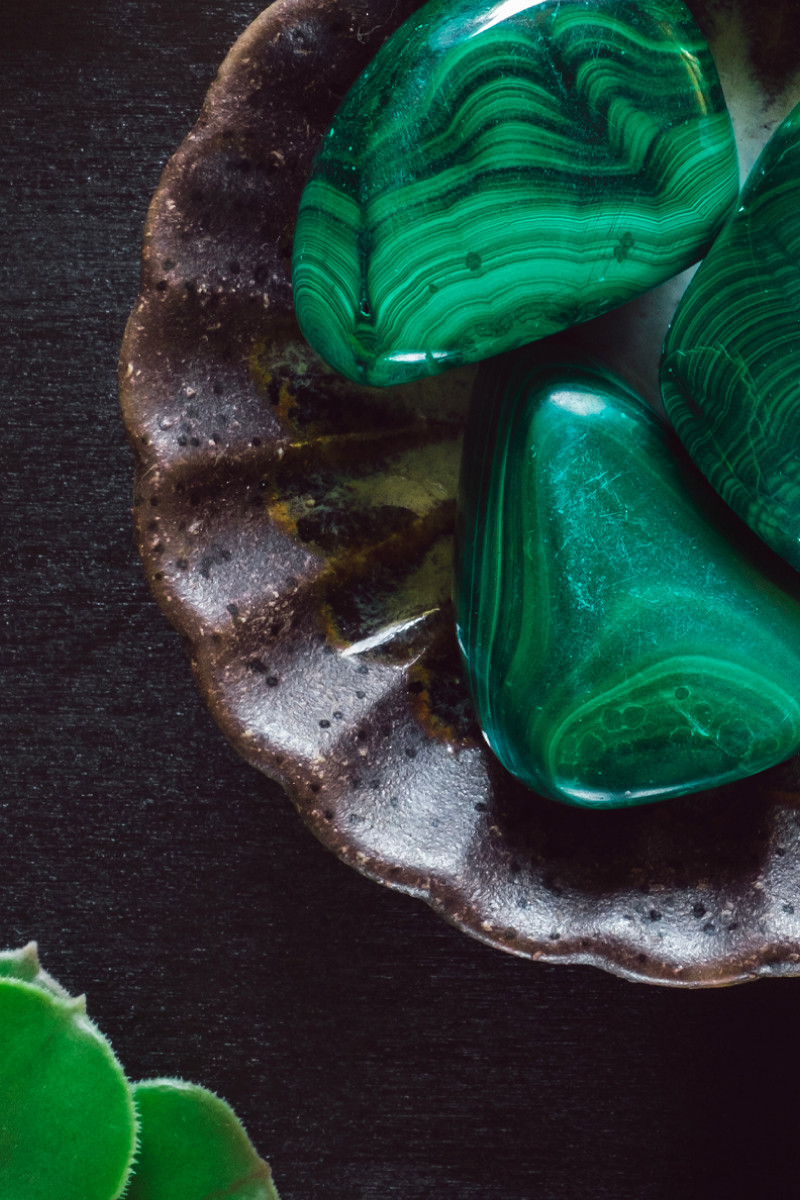
Modern Uses
The admiration of malachite stone continues today, too. Ever heard of the World Cup? Well, what you might not know is that the one-and-only FIFA World Cup trophy has malachite on it. Since 1974, this exclusive award has been admired by many for its all-gold structure, accented by green rings of malachite at the base.
Lucky for most of us, you don’t need to win a competition to come into contact with malachite. Many people use it for its spiritual properties or simply for its lovely appeal in malachite jewelry pieces.
What is the spiritual meaning of malachite?
Malachite Stone Meaning
The name malachite, like many other gemstone names, comes from Ancient Greek.
Two Ancient Greek words contribute to the name: malachitis, the name for a green-leafed plant we call mallow, and malakos, which means “soft.” This makes sense since malachite stones share the same green shade as the mallow plant and have relatively low hardness.
Spiritually, malachite is called the “Stone of Transformation,” for the belief that it can rid its wearer of self-destructive habits and clarify its path toward self-improvement. Its other spiritual traits include providing protection, wisdom, and openness to new experiences.
We’ve explored the metaphysical properties of malachite, so now it’s time to apply them. What is malachite stone good for?
Other societies used malachite for its metaphysical properties. They believed that wearing malachite could protect them from harmful external forces, physical or supernatural. For example, people in the Middle Ages carried malachite for protection against the evil eye and witchcraft.
Malachite Spiritual and Healing Properties
The malachite stone benefits for healing mainly focus on deep, internal wounds. It can help us address the ways we hold ourselves back: clinging to our fears or limiting beliefs about who we are and what we’re capable of.
In a more literal sense, the physical healing benefits of malachite are said to relieve pain from deep, internal ailments like arthritis, high blood pressure, menstrual cramps, and asthma.
Malachite can also heal emotionally, and one way is through chakra healing.
What chakra is malachite for? Malachite is a great stone for activating or balancing the Solar Plexus chakra. You’ll know this chakra is blocked when you keep finding yourself confused, stuck, or anxious about others’ opinions.
With malachite stones, you can open up this chakra to restore your confidence and feel more lively and expressive. By placing it near your sternum and allowing it to absorb all the built-up emotions inside you, malachite can bring healing and a feeling of control over your own destiny.
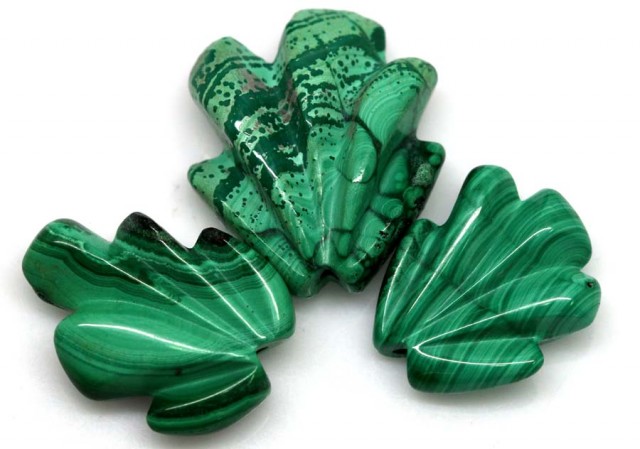
Malachite Stone Origins and Sources
Malachite mines are almost always in the weathering zones of copper deposits. Weathering zones are areas above deposits that get broken down by elements like water, wind, and pressure.
Malachite also forms as a secondary mineral, rather than a primary mineral. Primary minerals form when a rock first crystallizes. Weathering can change the chemical composition of these minerals until you get a new, secondary mineral.
In malachite’s case, the mineral forms in one of two ways: A solution of water and carbonates alters a rock with copper in it, or a solution of water and copper minerals alters a carbonate rock.
You’ll often find malachite inside of limestone or with other copper minerals like azurite and chrysocolla. So where in the world can you find these?
Mining Deposits
Some of the key malachite mines are in the Democratic Republic of Congo, Namibia, Australia, France, Israel, and the U.S.
Historically, the largest producers of malachite were Russia, Israel, and Egypt. Most of these mines have run dry, though. Now, the most abundant supply of malachite comes from the Democratic Republic of Congo. Nearly all the banded malachite stones used as gemstones are mined here.
Arizona is the main U.S. source, but malachite also comes out of the nearby states of New Mexico and Utah.
No matter where it comes from, malachite is a great gem to have. To make sure your malachite stone lasts as long as possible, it’s important to know how to take care of it.
Malachite Care and Maintenance
Malachite is incredibly sensitive to heat, so that’s the first crucial element for knowing how to care for malachite. Luckily, its gorgeous green color won’t fade from light exposure.
To protect your malachite stone, it’s best to avoid exposing it to:
Heat, including hot water
Tap water
Ultrasonic cleaners
Hard impacts
Weak acids
Harder gemstones
Can you wear malachite every day? Absolutely! However, it may start to look duller more quickly. Another factor to consider is where you live. If you live in a place with high temperatures, the heat sensitivity of malachite could cause it to degrade if you wear it outside daily.
If you’re worried about your malachite stone breaking, you can find stones with wax or resin coatings that won’t break as easily.
In terms of how to clean malachite, we suggest sticking to distilled water to rinse off dust or debris and leaving it to air dry.
Those who use gemstones for spiritual practices might wonder: Do you need to cleanse malachite? Yes, the negative energy the stone absorbs over time can clog it up, so we suggest cleansing it regularly.
There are a few ways to cleanse malachite:
Put it on clear quartz stones and leave overnight
In a bowl, pour enough sea salt to form a foundation layer and put your malachite on top of the salt. Leave this under moonlight overnight.
Bury malachite in fertile soil and leave for 2-3 days.
Smudge the stone with sage smoke.
Are you jazzed on malachite yet? If so, you may want to know about market prices.
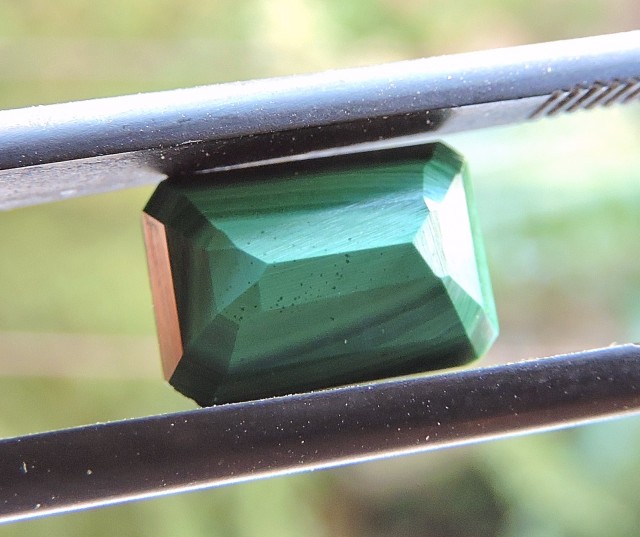
Malachite Stone Price and Value
Is malachite expensive? Thanks to malachite’s abundance, it’s super affordable. The malachite price per carat is typically about $1 to $3. Wholesale prices are on the lower end of this, while retail prices are on the higher end.
The value of malachite increases when the stone shows rarer traits. For instance, stones that grew in a unique way, like inside another rock or in an abnormal crystal structure, are generally more valuable. Malachite stones that display a cat’s eye effect, or chatoyance, will also command higher prices.
The most expensive specimens are typically large and show some of these unique traits. These can weigh between 3000 to over 32,000 carats and cost anywhere between $500 to $3,000. Most malachite pieces are under $50, though.
Popular cuts like cabochons or tumbled stones of malachite often come in bundles and can cost around $20-40.
The bottom line? It’s easy to find an affordable malachite stone in the right shape and size for you.
Ready for a Spiritual Renewal?
That wraps up everything you need to know about malachite! Now that you know all about malachite meanings and uses, you can see why this stone has been a favorite among everyone from ancient royalty to everyday gem collectors.
Malachite has taken a long journey throughout history and into the modern world. And while we may not wear it as eye shadow like the ancient Egyptians, we can still revel in its beauty with a malachite bracelet or malachite tumbled stone for meditation.
If you’ve been searching for a tool for self-reflection, malachite’s transformative powers may help you become more self-aware, bring clarity to what you’re feeling, and start your journey toward positive change.
As Marcus Aurelius said, “The soul becomes dyed with the color of its thoughts.”
If your soul could use a cleansing renewal, malachite’s healing green energy can infuse it with vitality, like a mallow plant blooming in springtime.
Feeling up for some rejuvenation? Buy a malachite stone today!
Search the Gemstone Encyclopedia
Related Auctions
Related Articles
Azotic treatment of Topaz and Quartz is a treatment that creates a layer of color over a gemstone. Learn more about this treatment and check out our stones fro sale.
8th May 2018
Quartz and Topaz are two of the most common minerals on the planet. They also look very similar. Let's look at some properties of them and compare Quartz and Topaz.
23rd Oct 2018
Gemstones and crystals are capable of absorbing and conveying energy, that’s why it’s important to cleanse, re-charge and program your stones so that they may achieve their best potential.
9th May 2018
Latest Articles
Tantalite is a group of red, brown, or black minerals containing the rare and valuable element tantalum. Discover the uses, history, prices, and properties of tantalite gemstones in this guide!
11th Nov 2024
Hodgkinsonite is a very rare collector’s gemstone known for its vibrant pink or purple hues, only found in New Jersey, USA. Learn hodgkinsonite’s prices, history, properties, and traits in this guide!
9th Jun 2024
Canasite is a rare mineral usually found as greenish-yellow inclusions in charoite but also known as a purple gemstone. Learn canasite’s history, varieties, properties, and prices in this guide.
27th May 2024
Article Categories
How To's is where you will find helpful articles from gem Rock Auctions on how to cut gemstones, select gemstones and buy gemstones.
9 Articles

